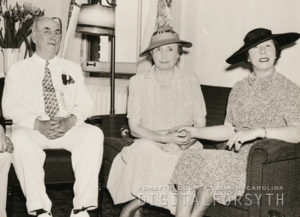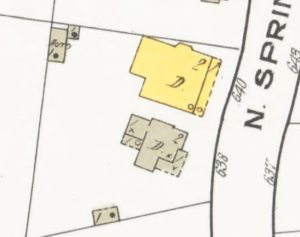640 N. Spring Street
Contributing, ca. 1909
The Linville-Hastings House is a large, two-story frame, Colonial Revival dwelling with relatively simple form but interesting detail. The truncated hip roof has small hipped dormers and a larger center front gabled dormer which exhibits a rare and delightful example in the West End of colored glass and rock objects trouve work. The front porch has clustered Tuscan columns set on granite-capped brick plinths. The glass paneled entrance with beveled and leaded glass sidelights and transom leads to a well-developed Colonial Revival interior with a closed string stair, a high paneled wainscot, sliding pocket doors, and mantels with mirrored over-mantels and decorative tile work.
Changes to the house include the addition of aluminum siding (mid-twentieth century), the removal a balustrade above the center bay of the porch (date unknown) and the recent addition of a wooden fire stair at the north end of the porch. Despite these changes, and the fact that during the mid-twentieth century the house was sensitively converted to four apartments, it retains its basic form and most of its significant details and therefore still contributes to the architectural character of Spring Street and the West End.

Original occupants were Dr. W. Clinton Linville and his wife, Fannie. By 1920, Linville’s sister, Bettie, and her husband, Gideon H. Hastings, an attorney (later a judge), were living in the house. They purchased it in 1922 and retained ownership until 1941. (CD, TR, SH, OS)
 1917 Sanborn Map, page 86 at “640” N. Spring
1917 Sanborn Map, page 86 at “640” N. Spring
